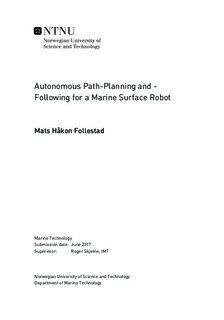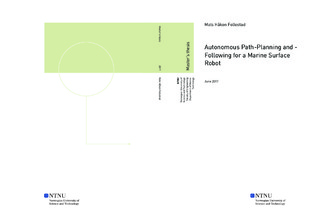| dc.description.abstract | Autonomous navigation for unmanned surface vessels is a modern and rapidly growing field of research. In recent years, many concepts and solutions have been proposed in order to achieve autonomous control of marine vessels. This thesis reviews the development of an autonomous path-planning and -following system with obstacle avoidance to avoid collisions, for a model-scale surface vessel. The system was developed to be able to navigate in a global or locally known map of static obstacles, where there were uncertainties regrading unknown static and dynamic obstacle present in the area of operation.
A LIDAR was used as a proximity sensor, in order for the system to sense the environment and to map the dynamic obstacles in the vicinity of the vessel, and in addition perform simultaneously localization and mapping. This information was used by the collision avoidance system in order to avoid obstacles.
The autonomous path planner used in this thesis is a slightly modified version of the A* algorithm, that generates a path towards a set goal. In order to follow the path, a Line of Sight steering law has been implemented, that has been modified for use on an omnidirectional vessel. A modified version of the Dynamic Window algorithm has been developed and implemented, to enable the vessel to avoid dynamic obstacles that is met along the path. The system was designed for use on the omnidirectional vessel named the CS Saucer, which was used as the platform to test the resulting system in the NTNU Marine Cybernetics Laboratory.
The experiments and computer simulations showed that the collision avoidance system could handle static obstacles very well. The collision avoidance system was also shown to handle dynamic obstacles, but there were some limitations to the system in this regards. This was mainly due to the dynamic obstacles velocity not being estimated and compensated for. This should be the main focus of further work, as well as using the obstacle velocity information to make the collision avoidance system abide the International Regulations for Avoiding Collision at Sea (COLREGS). | |

